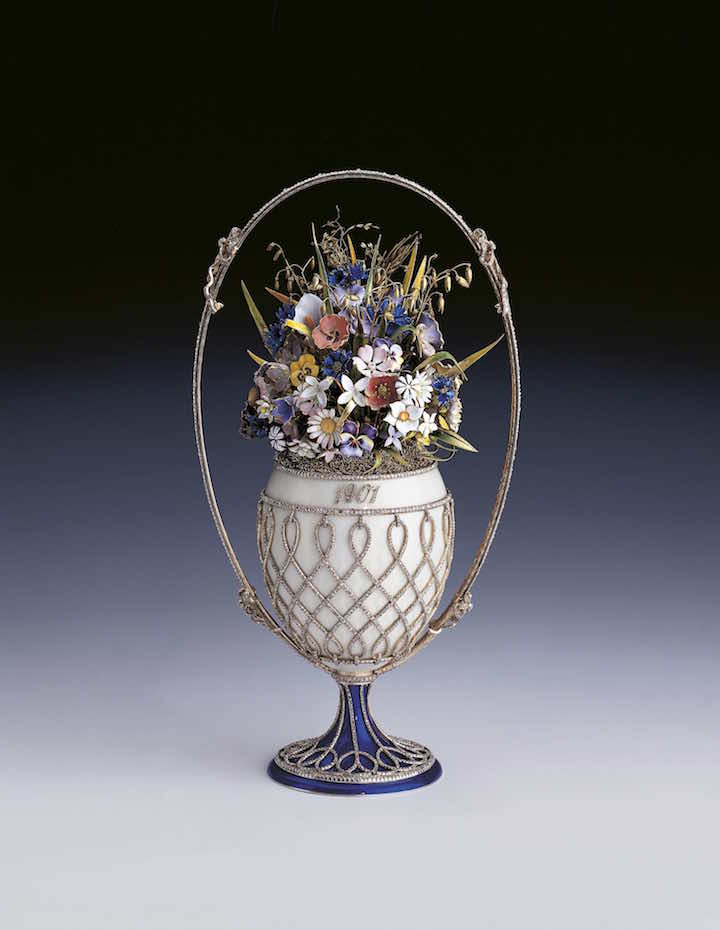Many succumbed to Russian art fatigue this year long before October even came around. But those with reserves of stamina will be rewarded by a visit to the Sainsbury Centre for Visual Arts in Norwich, where two parallel exhibitions offer – if such a thing were possible – a fresh perspective on 1917.
The strength of ‘Royal Fabergé’ and ‘Radical Russia’ lies in their juxtaposition, which demonstrates the gulf between two worlds that was already yawning in Russia well before the revolution. While the imperial family withdrew to Tsarskoye Selo to play with Fabergé’s tiny, exquisite baubles, the growing clamour for change in the country had already found a cultural outlet in the avant-garde ateliers of Moscow, St Petersburg, Kiev and Odessa. By the time Kazimir Malevich painted his Black Square in 1915, the revolution in art was well under way.
The Basket of Flowers Egg (1901), Fabergé. Royal Collection Trust / © Her Majesty Queen Elizabeth II 2017

When the Danish princesses Alexandra and Dagmar married the future Edward VII and Tsar Alexander III in the 1860s, the sisters made it their life’s work to bring together their husbands’ lately competing empires in alliance against Germany. The princesses’ sustained patronage of Fabergé over their lifetimes – and the opening in London of his only shop outside the Russian Empire – had a role to play in realising this rapprochement. These days you’d probably call it ‘soft power’.
‘Royal Fabergé’, which gathers over 100 objects from the British Royal Family’s collection, showcases the virtuosity of the master artist-craftsman and his St Petersburg studio: an agate box-potato; a silver drinking vessel shaped like a Viking longboat; a blingy panagia (an Orthodox bishop’s pendant) that would look quite at home today around the neck of Patriarch Kirill. Inevitably, the masterpiece is an egg: the Basket of Flowers, a tour de force in cloisonné enamelling and breathtaking naturalism presented by Nicholas II to his wife at Easter in 1901.
Queen Alexandra’s Dormouse (c. 1910), Fabergé. Royal Collection Trust / © Her Majesty Queen Elizabeth II 2017

The exhibition is centred on a collection of Fabergé animals sculpted from life on the model farm at Sandringham; there are plenty of dogs and horses, as per the age-old Royal obsession. Commissioned by Edward VII for his wife at the suggestion of his mistress Alice Keppel, and produced back in St Petersburg, this gemstone menagerie is both bucolic and excessive: did the guinea pig really need cabochon rubies for eyes? Well, yes: after all, these are tokens of international diplomacy. Most date from 1907, the year of the Anglo-Russian entente: a good year for the king to order a job lot of Fabergé.
While pre-revolutionary work by the likes of Malevich, Wassily Kandinsky and Natalia Goncharova is represented in ‘Radical Russia’, the exhibition focusses on the years after 1917, when the subversive figures of the avant-garde found themselves pressed into service by the People’s Commissariat of Enlightenment as mouthpieces of the revolution. In stark contrast to Fabergé’s objects, whose size and preciousness demand a private audience, this is art for mass consumption – stage set maquettes, book covers, propaganda posters and architectural designs.
La Foret (c. 1913), Natalia Goncharova. © ADAGP, Paris and DACS, London 2016. Photo: Antonia Reeve

To grizzled veterans of this year’s centenary exhibitions, much of this will be familiar: El Lissitzky typography, Liubov Popova’s ‘spatial force’ paintings, Constructivist models. In fact, in those that attended the Royal Academy’s ‘Revolution: Russian Art 1917–1932’, the model of Tatlin’s tower on the Sainsbury Centre’s lawn will quite literally induce déjà-vu: it is the same one that graced the Academy’s courtyard.
There are two highlights. First, a whole wall of Soviet porcelain – a curious clash of form and content that’s always a treat to behold. When the Bolsheviks nationalised the Imperial Porcelain Factory in March 1918, they found hundreds of unpatterned plates, which they commissioned Soviet painters to decorate with revolutionary slogans and avant-garde motifs. It was hardly porcelain for the people: their prohibitive cost meant that pieces tended to be sold abroad at art fairs. They kept at it until they ran out of plates.
Pawn from the chess set ‘Reds and Whites’ (1922–25), Natalia Dan’ko. Photo: Aigars Altenbergs

The most extraordinary thing, however, is a photograph of Malevich’s funeral procession in 1935. The painter’s coffin, borne on the back of a car, is in Suprematist design. But what catches the eye is the replica of his Black Square fixed to the radiator grille. The avant-garde had died five or six years earlier with the rise of Stalin – but this was the chance to mourn it, along with perhaps its greatest exponent.
‘Royal Fabergé’ and ‘Radical Russia’ are at the Sainsbury Centre for Visual Arts, Norwich, until 11 February 2018.



